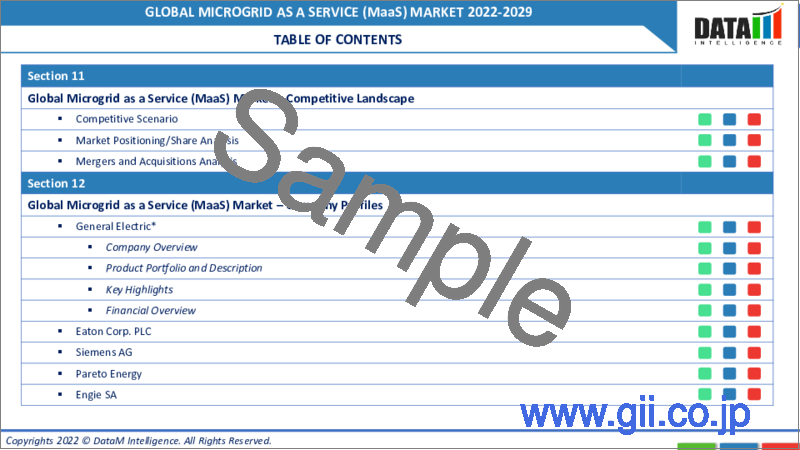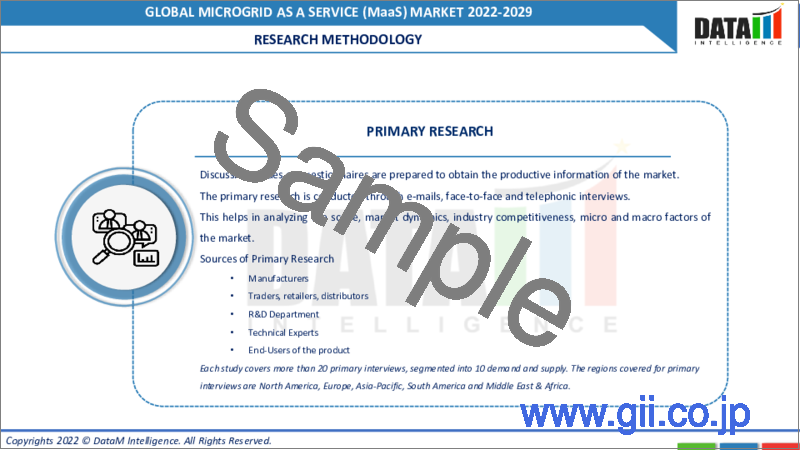|
|
市場調査レポート
商品コード
1117992
サービスとしてのマイクログリッド(MaaS)の世界市場-2022-2029Global Microgrid as a Service (MaaS) Market - 2022-2029 |
||||||
|
● お客様のご希望に応じて、既存データの加工や未掲載情報(例:国別セグメント)の追加などの対応が可能です。 詳細はお問い合わせください。 |
|||||||
| サービスとしてのマイクログリッド(MaaS)の世界市場-2022-2029 |
|
出版日: 2022年08月22日
発行: DataM Intelligence
ページ情報: 英文 210 Pages
納期: 約2営業日
|
- 全表示
- 概要
- 目次
市場力学
電力需要に対応するための技術革新が進み、MaaSの市場シェアが拡大
米国エネルギー情報局(EIA)によると、世界のエネルギー消費量は2040年までに約56%増加すると予想されています。また、産業や都市化の進展により、エネルギー消費量は急速に増加しており、主要なネットワークですべてをまかなうことができない状況です。これらのギャップは、電力供給サービスを拡大しようとするマイクログリッド企業にとって、ビジネスの可能性につながります。
EIAによると、インドと中国は急速に産業が拡大しており、2040年までに世界のエネルギー消費量増加の半分を占めるようになると言われています。これらの国々や米国における産業の発展が、世界のエネルギー産業を推進し、マイクログリッドの需要を押し上げているのです。
したがって、企業は電力需要の増加によるマイクログリッドの需要増を克服するサービス技術として、マイクログリッドに投資しています。いくつかの技術的な改良は、マイクログリッドの無停電電源供給を確実にするために、バッテリー・インバータの性能強化に向けられています。
マイクログリッドサービス業界のメーカーは、より大きな出力を持つバッテリー技術を開発し、そのモデルでエンドユーザー部門に深く入り込もうと考えています。炭素排出量の削減を目指すクリーンパワープラン(CPP)などの取り組みにより、バイオパワー、風力発電、太陽光発電などの再生可能エネルギーが成長する道が開かれつつあります。マイクログリッドの性能は、特に無線技術やIoT技術の発達により、人手を介さないリアルタイムのデータストリーミング、処理、ストレージ、監視インフラによって最適化することが可能です。
また、メーカーはMaaSの機能を利用して、長距離の配電線への依存を減らし、送電ロスを低減することができます。ブロックチェーン技術とMaaSの組み合わせは、取引の信頼性を高めるのに役立つ。市場参加者は、この技術をマイクログリッドに統合することで、より便利で安全に支払いを管理できるようになるため、利益を得ることができます。
MaaSは複雑であるため、様々な課題が発生し、技術の発展を阻害しています。
マイクログリッド・アズ・サービス方式は、当初から複雑とされてきました。マイクログリッドの複雑な計画・設計や、センサー、コントローラー、レゾルバー、エンコーダーなどの統合が、システムの複雑さをさらに高めています。
このような複雑なシステムの導入には、有能な人材が必要ですが、専門家の不足が長期的に導入率に影響を与える可能性があります。さらに、マイクログリッドに関する政府の規制が厳しく、個人所有のマイクログリッドの普及率が高まっていることも、マイクログリッド・サービス市場の著しい成長を阻害する要因になると予想されます。
さらに、高価な先行投資であるCAPEXとOPEXの要件と規制規制への適合が義務付けられているという2つの重要な要因から、MaaS市場は新規参入のリスクが低いという状況にあります。さらに、エンドユーザーの理解不足と構造の複雑化が、MaaS(Microgrid as a Service)市場の成長を阻む2つの主な障害となっています。このように、予測期間を通じて、MaaS(Micro Grid as a Service)市場は、計画・開拓の複雑さと一般市民の認識不足によって阻害される可能性が高いと考えられます。
COVID-19の影響分析
COVID-19の大流行は、世界経済に様々な影響を与えています。世界経済全体に響いたビジネスへの通常のショックとは別に、エネルギー産業への最も目に見える反響として、石油の需要(およびそれに対応する価格)が劇的に低下したことが挙げられます。短期的、長期的な反響はありますが、明確なデータは、ひどい世界的危機にもかかわらず、サービスとしてのマイクログリッドは2桁で成長することを示しています。
しかし、この拡大は、異なる市場部門への不均等な影響と、多様な分散型エネルギー資源(DER)技術の受け入れ可能性によって定義されるでしょう。さらに、2020年のプロジェクトの遅れは2021年に及ぶと予測されるが、COVID-19はサービスとしてのマイクログリッドの長期的な見通しを改善することが期待されます。
気候変動(とそれに伴う異常気象)、山火事、公共インフラへのテロ攻撃の激化などは、通常通りのビジネスができない世界の混乱のほんの一部に過ぎません。
世界のマイクログリッド as a service(MaaS)市場レポートでは、約61の市場データ表、54の図、210ページの構成で提供しています。
目次
第1章 サービスとしてのマイクログリッド(MaaS)世界市場の調査手法と範囲
- 調査手法
- 調査目的・調査範囲
第2章 サービスとしてのマイクログリッド(MaaS)の世界市場- 市場の定義と概要
第3章 サービスとしてのマイクログリッド(MaaS)の世界市場-エグゼクティブサマリー
- グリッド別市場内訳
- サービス別市場内訳
- エンドユーザー別市場内訳
- 地域別市場内訳
第4章 サービスとしてのマイクログリッド(MaaS)の世界市場-市場力学
- 市場影響要因
- 促進要因
- 電力需要を満たすための技術的進歩の高まりがMaaSの市場シェアを拡大
- 抑制要因
- MaaSの複雑性が様々な課題の発生につながり、技術の成長を阻害しています。
- ビジネスチャンス
- 影響分析
- 促進要因
第5章 サービスとしてのマイクログリッド(MaaS)の世界市場- 産業分析
- ポーターのファイブフォース分析
- サプライチェーン分析
- 価格設定分析
- 規制分析
第6章 サービスとしてのマイクログリッド(MaaS)の世界市場-COVID-19分析
- COVID-19の市場に関する分析
- COVID-19登場前の市場シナリオ
- COVID-19の現在の市場シナリオ
- COVID-19以降、または今後のシナリオ
- COVID-19の中でのプライシングダイナミクス
- 需要-供給スペクトラム
- パンデミック時の市場に関連する政府の取り組み
- メーカーの戦略的な取り組み
- まとめ
第7章 サービスとしてのマイクログリッド(MaaS)の世界市場-グリッド別
- グリッド接続型
- リモート/アイランド
第8章 サービスとしてのマイクログリッド(MaaS)の世界市場- サービス別
- エンジニアリング&デザインサービス
- サービスとしてのソフトウェア(SaaS)
- 監視・制御サービス
- 運用・保守サービス
第9章 サービスとしてのマイクログリッド(MaaS)の世界市場-エンドユーザー別
- 政府・教育機関
- 産業用
- 軍事用
- 住宅・商業施設
- ユーティリティ
第10章 サービスとしてのマイクログリッド(MaaS)の世界市場-地域別
- 北米
- 米国
- カナダ
- メキシコ
- 欧州
- ドイツ
- 英国
- フランス
- イタリア
- スペイン
- その他欧州
- 南米
- ブラジル
- アルゼンチン
- その他の南米地域
- アジア太平洋地域
- 中国
- インド
- 日本
- 韓国
- その他アジア太平洋地域
- 中東・アフリカ地域
第11章 サービスとしてのマイクログリッド(MaaS)の世界市場- 競争情勢
- 競合シナリオ
- 市況分析/シェア分析
- M&A(合併・買収)分析
第12章 サービスとしてのマイクログリッド(MaaS)の世界市場-企業プロファイル
- General Electric
- 企業概要
- エンドユーザー向けポートフォリオと説明
- 主なハイライト
- 財務概要
- Eaton Corp. PLC
- Siemens AG
- Pareto Energy
- Engie SA
- Spirae, Inc
- Green Energy Corporation
- Anbaric Development Partners
- NRG Energy, Inc
- Duke Energy Corporation
第13章 サービスとしてのマイクログリッド(MaaS)の世界市場-重要考察
第14章 サービスとしてのマイクログリッド(MaaS)の世界市場-DataM
Market Overview
Microgrid as a service (MaaS) market size was worth US$ YY million in 2021 and is estimated to show significant growth by reaching up to US$ YY million by 2029, growing at a CAGR of 15.6% within the forecast period (2022-2029).
Microgrids-as-a-Service (MaaS) is a brand-new, industry-leading financing method that allows businesses to establish microgrids with no upfront costs. Microgrids-as-a-Service eliminates the financial risk and complexity, allowing more microgrids to be built.
MaaS suppliers arrange financing and operation and maintenance agreements in addition to offering hardware and software, making microgrid deployment a comprehensive option. The microgrid-as-a-service (MaaS) model is experiencing rapid expansion, owing to its cost advantages over older methods.
The underperformance of existing grids with outdated infrastructures is a crucial success element pulling the microgrid-as-a-service sector forward. With government funds, U.S. Department of Energy has launched the Smart Grid Investment Grant (SGIG) program to speed up the transition from traditional electric transmission networks to modernized systems.
Market Dynamics
Growing technological advancements to fulfill electricity demand has escalated the market share for MaaS
Growing technological advancements to fulfill electricity demand has escalated the market share for MaaS
Global energy consumption is expected to rise by roughly 56% by 2040, according to US Energy Information Administration (EIA). Furthermore, due to increased industry and urbanization, energy consumption is increasing rapidly, which is not met entirely by major networks. These gaps translate into business possibilities for microgrid companies looking to expand their power supply services.
According to the EIA, India and China are undergoing rapid industrial expansion and by 2040, they will account for half of the world's total increase in energy consumption. Industrial development in these countries and U.S. is propelling the global energy industry and boosting the demand for the microgrid.
Thus, companies are investing in microgrids as a service technology that overcomes the growing demand for microgrids due to increased electricity demand. Several technological improvements have been directed toward enhancing the performance of battery inverters to ensure a microgrid's uninterrupted power supply.
Manufacturers in the microgrid-as-a-service industry are looking to create battery technology with larger power outputs to enter deeper into end-user sectors with their models. Initiatives like the Clean Power Plan (CPP), which aims to reduce carbon emissions, are opening the way to grow renewable energy sources like biopower, wind power and solar power. The performance of microgrids can be optimized by real-time data streaming, processing, storage and monitoring infrastructure, which eliminates any human intervention, especially with the development of wireless and IoT technologies.
Manufacturers can also use MaaS's capabilities to lessen reliance on long-distance distribution lines, lowering transmission losses. The combination of Blockchain technology and MaaS will help to increase transaction trust. Market participants will benefit from integrating this technology with microgrids since they will be able to manage payments more conveniently and securely.
The complexity of MaaS leads to the generation of various challenges, thus hurdling the growth of the technology
The microgrid-as-a-service approach has been regarded as complicated since its start. The complicated planning and design of microgrids and integration sensors, controllers, resolvers and encoders add to the system's complexity.
The deployment of such a complicated system necessitates competent personnel; nevertheless, a shortage of specialists might have a long-term influence on adoption rates. Besides that, stringent government regulations related to microgrids and the rising adoption rate of individually-owned microgrids are expected to stifle the microgrid-as-a-service market's spectacular growth.
Furthermore, because of two important factors: expensive upfront CAPEX and OPEX requirements and mandated conformance to regulatory regulations, the MaaS market faces a low risk of new competitors. In addition, the lack of understanding among end-users and the increasing structure complexity are two main roadblocks to the microgrid as a service (MaaS) market's growth. Thus, throughout the projection period, the micro-grid as a service (MaaS) market is likely impeded by the complexity of planning and development and a lack of public awareness.
COVID-19 Impact Analysis
The COVID-19 pandemic has impacted the world economy in various ways. Apart from a normal shock to business that resonated across the global economy, one of the most visible repercussions on the energy industry was a dramatic fall in demand (and corresponding price) for oil. There are short- and long-term repercussions, but clear data indicates that microgrid as a service will grow in double digits despite a terrible global crisis.
However, the expansion will be defined by unequal impacts on different market sectors and the acceptability of diverse distributed energy resources (DER) technologies. Furthermore, while project delays in 2020 are predicted to extend into 2021, COVID-19 is expected to improve the long-term outlook for microgrid as a service.
Climate change (and the accompanying extreme weather), wildfires and escalating terrorist attacks on public infrastructure are just a few of the global disruptions to business as usual.
Segment Analysis
The global microgrid as a service (MaaS) market is segmented based on grid, service, end-user and region.
Rising demand for remote microgrids in rural areas and remote areas has boosted the segmental growth of the technology
The global microgrid as a service (MaaS) market is segmented into grid-connected and remote/islanded microgrids based on the grid.
Among the mentioned grids, remote/islanded microgrid holds a dominating market share in the global microgrid as a service market. The segment allows facilities to manage distributed energy sources better and achieve greater control in meeting energy demands. Furthermore, due to unavailable and inexpensive transmission and distribution (T&D) infrastructure nearby, remote/islanded microgrids are physically disconnected from the utility grid and operate in island mode.
Renewables, such as wind and solar, often provide a more cost-effective and ecologically sustainable DER solution for the microgrid operator in these remote scenarios. In addition, several remote microgrids are contemplating battery energy storage devices for backup power instead of traditional generators.
Furthermore, remote microgrids have many advantages for utilities and their consumers, particularly when serving individuals in rural and remote areas. The utility can own the microgrid and use it as a distributed energy resource (DER), giving remote consumers the same level of reliability as non-remote customers. In addition, remote microgrids have a more consistent level of reliability than before the microgrid.
Geographical Analysis
In Asia-Pacific, increased expenditures on microgrid infrastructure and growing demand for a continuous, uninterrupted, dependable power supply and electricity strengthen the microgrid as a Service (MaaS) regional market share.
The significant investments in microgrid infrastructure and the growing demand for a continuous, uninterrupted and dependable supply of power and electricity are driving the market expansion of microgrid as a service in Asia-Pacific.
Furthermore, growth in the microgrid market in the region has created huge market opportunities for the technology to grow in the forecast period. The growth is primarily ascribed to the low electrification rate and grid connectivity, coupled with the high demand for power in the region.
The market in Asia-Pacific is expected to grow rapidly during the projected period, owing to the region's growing industrialization and urbanization, particularly in China and India. Furthermore, governments in Asia-Pacific countries intend to boost distributed energy generation and microgrids to provide electricity to their citizens.
Furthermore, the North American area is expected to grow significantly during the projection period. U.S. is the largest market for microgrids as a service globally. In U.S., the market is always changing and evolving, especially in the electrical supply sector, leading to huge market growth trends in the microgrid as a service market.
Competitive Landscape
The global microgrid as a service (MaaS) market is highly competitive with local and global key players. Some key players contributing to the market's growth are General Electric, Eaton Corp. PLC, Siemens AG, Pareto Energy, Engie SA, Spirae, Inc, Green Energy Corporation, Anbaric Development Partners, NRG Energy, Inc, Duke Energy Corporation and others.
The major companies are adopting several growth strategies such as product launches, acquisitions and collaborations, contributing to the global growth of the microgrid as a service (MaaS) market.
For instance, in February 2018, ABB announced the delivery of an ABB Ability-enabled microgrid and storage system to integrate renewable solar and wind energy into the enormous tropical island's power supply, decreasing the fossil fuel requirement and lowering the carbon impact. ABB is a pioneer in microgrids, which are excellent for isolated places such as islands that are difficult to connect to main power grids due to their size and capacity.
General Electric
Overview: General Electric Company is an international conglomerate incorporated in New York City and headquartered in Boston, Massachusetts, U.S. The company involves in the operations of the following business segments: aviation, healthcare, power, renewable energy, digital industry, additive manufacturing and venture capital and finance. The company's products and services offering extends from aircraft engines, power generation, water processing and household appliances to medical imaging, business and consumer financing and industrial products
Product Portfolio: GridNode Microgrid Solutions: Electrification, decarbonization, digitization and decentralization are all global energy developments transforming the current energy scene. Microgrids are becoming more popular due to these trends and customer desire for solutions that provide increased reliability, resiliency, sustainability, energy independence and cost savings.
GridNode Microgrid Solution from GE delivers real-time control and energy optimization, allowing customers to get the most return on their investment (ROI) from their systems.
Operations management, transition management, dispatch control and energy optimization, operations planning and market involvement are all included in the GridNode Microgrid Solution's control and automation features.
Key Development
On November 09, 2021, the opening of the new cutting-edge microgrid control lab at University of Central Florida was celebrated by Florida Power & Light Company (FPL) and GE Digital (UCF). The lab will be a cutting-edge research facility and control room for engineering instructors and students. The lab at UCF is co-sponsored by FPL and GE Digital. It will include control center equipment and software that students will use to mimic and test real-life grid control operations, such as identifying ways to optimize and safeguard the future grid.
Why Purchase the Report?
- Visualize the global microgrid as a service (MaaS) market segmentation by grid, service, end-user and region, highlighting key commercial assets and players.
- Identify commercial opportunities in the microgrid as a service (MaaS) market by analyzing trends and co-development deals.
- Excel data sheet with thousands of global microgrid as a service (MaaS) market-level 4/5 segmentation points.
- PDF report with the most relevant analysis cogently put together after exhaustive qualitative interviews and in-depth market study.
- Product mapping in excel for the key product of all major market players
The global microgrid as a service (MaaS) market report would provide approximately 61 market data tables, 54 figures and 210 pages.
Target Audience 2022
- Service Providers/ Buyers
- Electronic Companies
- Research Laboratory
- Manufacturers
- Consumer Goods Companies
- Distributors
Table of Contents
1. Global Microgrid as a Service (MaaS) Market Methodology and Scope
- 1.1. Research Methodology
- 1.2. Research Objective and Scope of the Report
2. Global Microgrid as a Service (MaaS) Market - Market Definition and Overview
3. Global Microgrid as a Service (MaaS) Market - Executive Summary
- 3.1. Market Snippet by Grid
- 3.2. Market Snippet by Service
- 3.3. Market Snippet by End-User
- 3.4. Market Snippet by Region
4. Global Microgrid as a Service (MaaS) Market-Market Dynamics
- 4.1. Market Impacting Factors
- 4.1.1. Drivers
- 4.1.1.1. Growing technological advancements to fulfill electricity demand has escalated the market share for MaaS
- 4.1.1.2. XX
- 4.1.2. Restraints
- 4.1.2.1. The complexity of MaaS leads to the generation of various challenges, thus hurdling the growth of the technology
- 4.1.3. Opportunity
- 4.1.3.1. XX
- 4.1.4. Impact Analysis
- 4.1.1. Drivers
5. Global Microgrid as a Service (MaaS) Market - Industry Analysis
- 5.1. Porter's Five Forces Analysis
- 5.2. Supply Chain Analysis
- 5.3. Pricing Analysis
- 5.4. Regulatory Analysis
6. Global Microgrid as a Service (MaaS) Market - COVID-19 Analysis
- 6.1. Analysis of COVID-19 on the Market
- 6.1.1. Before COVID-19 Market Scenario
- 6.1.2. Present COVID-19 Market Scenario
- 6.1.3. After COVID-19 or Future Scenario
- 6.2. Pricing Dynamics Amid COVID-19
- 6.3. Demand-Supply Spectrum
- 6.4. Government Initiatives Related to the Market During Pandemic
- 6.5. Manufacturers Strategic Initiatives
- 6.6. Conclusion
7. Global Microgrid as a Service (MaaS) Market - By Grid
- 7.1. Introduction
- 7.1.1. Market Size Analysis and Y-o-Y Growth Analysis (%), By Grid
- 7.1.2. Market Attractiveness Index, By Grid
- 7.2. Grid-Connected *
- 7.2.1. Introduction
- 7.2.2. Market Size Analysis and Y-o-Y Growth Analysis (%)
- 7.3. Remote/Islanded
8. Global Microgrid as a Service (MaaS) Market - By Service
- 8.1. Introduction
- 8.1.1. Market Size Analysis and Y-o-Y Growth Analysis (%), By Service
- 8.1.2. Market Attractiveness Index, By Service
- 8.2. Engineering & Design Service *
- 8.2.1. Introduction
- 8.2.2. Market Size Analysis and Y-o-Y Growth Analysis (%)
- 8.3. Software as a Service (SaaS)
- 8.4. Monitoring & Control Service
- 8.5. Operation & Maintenance Service
9. Global Microgrid as a Service (MaaS) Market - By End-User
- 9.1. Introduction
- 9.1.1. Market Size Analysis and Y-o-Y Growth Analysis (%), By End-User
- 9.1.2. Market Attractiveness Index, By End-User
- 9.2. Government & Education *
- 9.2.1. Introduction
- 9.2.2. Market Size Analysis and Y-o-Y Growth Analysis (%)
- 9.3. Industrial
- 9.4. Military
- 9.5. Residential & Commercial
- 9.6. Utility
10. Global Microgrid as a Service (MaaS) Market - By Region
- 10.1. Introduction
- 10.1.1. Market Size Analysis and Y-o-Y Growth Analysis (%), By Region
- 10.1.2. Market Attractiveness Index, By Region
- 10.2. North America
- 10.2.1. Introduction
- 10.2.2. Key Region-Specific Dynamics
- 10.2.3. Market Size Analysis and Y-o-Y Growth Analysis (%), By Grid
- 10.2.4. Market Size Analysis and Y-o-Y Growth Analysis (%), By Service
- 10.2.5. Market Size Analysis and Y-o-Y Growth Analysis (%), By End-User
- 10.2.6. Market Size Analysis and Y-o-Y Growth Analysis (%), By Country
- 10.2.6.1. U.S.
- 10.2.6.2. Canada
- 10.2.6.3. Mexico
- 10.3. Europe
- 10.3.1. Introduction
- 10.3.2. Key Region-Specific Dynamics
- 10.3.3. Market Size Analysis and Y-o-Y Growth Analysis (%), By Grid
- 10.3.4. Market Size Analysis and Y-o-Y Growth Analysis (%), By Service
- 10.3.5. Market Size Analysis and Y-o-Y Growth Analysis (%), By End-User
- 10.3.6. Market Size Analysis and Y-o-Y Growth Analysis (%), By Country
- 10.3.6.1. Germany
- 10.3.6.2. UK
- 10.3.6.3. France
- 10.3.6.4. Italy
- 10.3.6.5. Spain
- 10.3.6.6. Rest of Europe
- 10.4. South America
- 10.4.1. Introduction
- 10.4.2. Key Region-Specific Dynamics
- 10.4.3. Market Size Analysis and Y-o-Y Growth Analysis (%), By Grid
- 10.4.4. Market Size Analysis and Y-o-Y Growth Analysis (%), By Service
- 10.4.5. Market Size Analysis and Y-o-Y Growth Analysis (%), By End-User
- 10.4.6. Market Size Analysis and Y-o-Y Growth Analysis (%), By Country
- 10.4.6.1. Brazil
- 10.4.6.2. Argentina
- 10.4.6.3. Rest of South America
- 10.5. Asia-Pacific
- 10.5.1. Introduction
- 10.5.2. Key Region-Specific Dynamics
- 10.5.3. Market Size Analysis and Y-o-Y Growth Analysis (%), By Grid
- 10.5.4. Market Size Analysis and Y-o-Y Growth Analysis (%), By Service
- 10.5.5. Market Size Analysis and Y-o-Y Growth Analysis (%), By End-User
- 10.5.6. Market Size Analysis and Y-o-Y Growth Analysis (%), By Country
- 10.5.6.1. China
- 10.5.6.2. India
- 10.5.6.3. Japan
- 10.5.6.4. South Korea
- 10.5.6.5. Rest of Asia-Pacific
- 10.6. Middle East and Africa
- 10.6.1. Introduction
- 10.6.2. Key Region-Specific Dynamics
- 10.6.3. Market Size Analysis and Y-o-Y Growth Analysis (%), By Grid
- 10.6.4. Market Size Analysis and Y-o-Y Growth Analysis (%), By Service
- 10.6.5. Market Size Analysis and Y-o-Y Growth Analysis (%), By End-User
11. Global Microgrid as a Service (MaaS) Market - Competitive Landscape
- 11.1. Competitive Scenario
- 11.2. Market Positioning/Share Analysis
- 11.3. Mergers and Acquisitions Analysis
12. Global Microgrid as a Service (MaaS) Market- Company Profiles
- 12.1. General Electric *
- 12.1.1. Company Overview
- 12.1.2. End-User Portfolio and Description
- 12.1.3. Key Highlights
- 12.1.4. Financial Overview
- 12.2. Eaton Corp. PLC
- 12.3. Siemens AG
- 12.4. Pareto Energy
- 12.5. Engie SA
- 12.6. Spirae, Inc
- 12.7. Green Energy Corporation
- 12.8. Anbaric Development Partners
- 12.9. NRG Energy, Inc
- 12.10. Duke Energy Corporation
LIST NOT EXHAUSTIVE
13. Global Microgrid as a Service (MaaS) Market - Premium Insights
14. Global Microgrid as a Service (MaaS) Market - DataM
- 14.1. Appendix
- 14.2. About Us and Services
- 14.3. Contact Us




